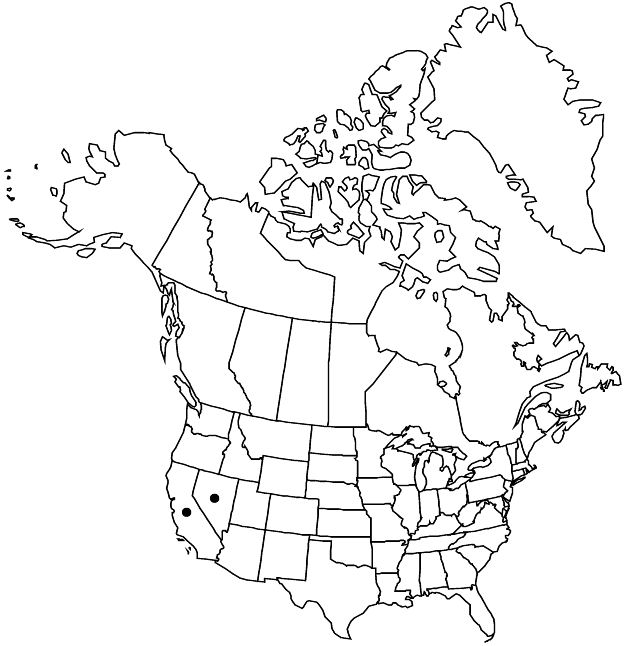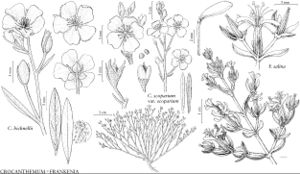Difference between revisions of "Frankenia salina"
Contr. Gray Herb. 70: 92. 1924.
FNA>Volume Importer |
FNA>Volume Importer |
||
| Line 19: | Line 19: | ||
|name=Frankenia grandifolia | |name=Frankenia grandifolia | ||
|authority=Chamisso & Schlechtendal | |authority=Chamisso & Schlechtendal | ||
| − | }}{{Treatment/ID/Synonym | + | }} {{Treatment/ID/Synonym |
|name=F. grandifolia subsp. campestris | |name=F. grandifolia subsp. campestris | ||
|authority=(A. Gray) A. E. Murray | |authority=(A. Gray) A. E. Murray | ||
| − | }}{{Treatment/ID/Synonym | + | }} {{Treatment/ID/Synonym |
|name=F. grandifolia var. campestris | |name=F. grandifolia var. campestris | ||
|authority=A. Gray | |authority=A. Gray | ||
| Line 40: | Line 40: | ||
|elevation=0–800 m | |elevation=0–800 m | ||
|distribution=Calif.;Nev.;Mexico (Baja California;Baja California Sur;Coahuila;San Luis Potosí;Sonora);South America (Chile);introduced in Pacific Islands (Hawaii). | |distribution=Calif.;Nev.;Mexico (Baja California;Baja California Sur;Coahuila;San Luis Potosí;Sonora);South America (Chile);introduced in Pacific Islands (Hawaii). | ||
| − | |discussion=<p>Frankenia salina, as circumscribed here, occurs in the United States, Mexico, and Chile. The North American and South American populations, which previously had been recognized as F. grandifolia and F. salina respectively, are now considered conspecific (M. A. Whalen 1987). In North America, F. salina occurs in California, Nevada, and Mexico (Baja California and Sonora, with some highly disjunct populations in Coahuila and San Luis Potosí). In California, it occurs in both coastal and inland areas and is common in coastal salt marshes. The inland and coastal populations have sometimes been recognized as F. grandifolia var. campestris and var. grandifolia, respectively. Plants from inland regions tend to have proportionally narrower leaves and shorter, lighter-colored petals than those from coastal regions; there is considerable variation in these traits within regions (Whalen) and these infraspecific taxa are not recognized here. Frankenia salina was introduced on Tern Island in Hawaii, where it was collected in 1968 (Herbst 1217 BISH); W. L. Wagner et al. (1990) noted that this population did not survive a 1969 storm.</p> | + | |discussion=<p><i>Frankenia salina</i>, as circumscribed here, occurs in the United States, Mexico, and Chile. The North American and South American populations, which previously had been recognized as <i>F. grandifolia</i> and <i>F. salina</i> respectively, are now considered conspecific (M. A. Whalen 1987). In North America, <i>F. salina</i> occurs in California, <i>Nevada</i>, and Mexico (Baja California and Sonora, with some highly disjunct populations in Coahuila and San Luis Potosí). In California, it occurs in both coastal and inland areas and is common in coastal salt marshes. The inland and coastal populations have sometimes been recognized as <i>F. grandifolia</i> <i></i>var.<i> campestris</i> and <i></i>var.<i> grandifolia</i>, respectively. Plants from inland regions tend to have proportionally narrower leaves and shorter, lighter-colored petals than those from coastal regions; there is considerable variation in these traits within regions (Whalen) and these infraspecific taxa are not recognized here. <i>Frankenia salina</i> was introduced on Tern Island in Hawaii, where it was collected in 1968 (Herbst 1217 BISH); W. L. Wagner et al. (1990) noted that this population did not survive a 1969 storm.</p> |
|tables= | |tables= | ||
|references= | |references= | ||
| Line 64: | Line 64: | ||
|publication year=1924 | |publication year=1924 | ||
|special status=Selected by author to be illustrated | |special status=Selected by author to be illustrated | ||
| − | |source xml=https://jpend@bitbucket.org/aafc-mbb/fna-data-curation.git/src/ | + | |source xml=https://jpend@bitbucket.org/aafc-mbb/fna-data-curation.git/src/8f726806613d60c220dc4493de13607dd3150896/coarse_grained_fna_xml/V6/V6_781.xml |
|genus=Frankenia | |genus=Frankenia | ||
|species=Frankenia salina | |species=Frankenia salina | ||
Revision as of 17:50, 18 September 2019
Subshrubs, sprawling, 1.2–6 dm; branches glabrous, or puberulous or short-pilose, hairs erect or suberect. Leaves: petiole (0.5–)0.7–2(–2.5) mm, not markedly tapering toward blade, apex ± similar in width to or narrower than base of blade; blade grayish yellow-green, usually obovate to narrowly oblanceolate, oblong-elliptic to linear, sometimes ovate or lanceolate, flat, 3–13.5 × 0.9–6(–7) mm, margins slightly to loosely revolute, abaxial surface mostly exposed, adaxial surface scattered-hairy to puberulous.
Phenology: Flowering Apr–Nov.
Habitat: Saline and alkaline soil, salt marshes, alkali flats
Elevation: 0–800 m
Distribution

Calif., Nev., Mexico (Baja California, Baja California Sur, Coahuila, San Luis Potosí, Sonora), South America (Chile), introduced in Pacific Islands (Hawaii).
Discussion
Frankenia salina, as circumscribed here, occurs in the United States, Mexico, and Chile. The North American and South American populations, which previously had been recognized as F. grandifolia and F. salina respectively, are now considered conspecific (M. A. Whalen 1987). In North America, F. salina occurs in California, Nevada, and Mexico (Baja California and Sonora, with some highly disjunct populations in Coahuila and San Luis Potosí). In California, it occurs in both coastal and inland areas and is common in coastal salt marshes. The inland and coastal populations have sometimes been recognized as F. grandifolia var. campestris and var. grandifolia, respectively. Plants from inland regions tend to have proportionally narrower leaves and shorter, lighter-colored petals than those from coastal regions; there is considerable variation in these traits within regions (Whalen) and these infraspecific taxa are not recognized here. Frankenia salina was introduced on Tern Island in Hawaii, where it was collected in 1968 (Herbst 1217 BISH); W. L. Wagner et al. (1990) noted that this population did not survive a 1969 storm.
Selected References
None.
